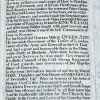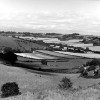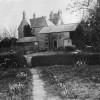Smith had an unusually stylised signature which, while distinctive was yet legible. His forename was scored through with a backstroke from the “B” that also served to cross the “T” in Boyton, before passing through the loop of the “H” in Smith, to extend some way beyond; the hook of the “H” was then doubled back in a broad sweeping arc to entablature the whole name of Smith. (See photo in photo section.)
How well Frederick W.B. Smith and Thomas Hardy knew each other has long been a matter of uncertainty and speculation. What is known for a fact is that the two men were born within three years – and within three miles – of each other, and were virtually fellow townsmen of Dorchester who most likely often saw each other in passing without being aware of each other’s identity. And while Boyton Smith was no writer, Hardy was an amateur musician, having learnt the violin and how to sight-read music from his father who had been a player in the family’s gallery band at Stinsford Church.
The two men however, were evidently in almost daily passing contact from as early as the late 1850’s, for the office of the architect John Hicks, where Hardy was working as an articled apprentice and to which he would have walked each day, was situated in South Street, where Smith was then living. This office was also next door to the home of the great schoolmaster poet and scholar William Barnes. But it is likely that the intermediary who brought Smith and Hardy together was Walter Fletcher, a long-time walking companion of the latter, who also happened to be a friend of both Boyton and Sydney Smith. Fletcher was present during Sydney’s last visit to his elder brother in 1877, and it is probable that, quite independently, Smith was acquainted with many of the same people in Dorchester as Hardy was. He would therefore be familiar with many of the same aspects of life in the neighbourhood, and would have been involved in many of the same organisations.
An example of this close involvement came in 1904, when Boyton Smith was commissioned by the Society of Dorset Men in London to set ‘Praise o’Dorset,’ a poem by Barnes, to music for the occasion of their inaugural meeting. For the 1922 Dorset Year Book the Society’s founder and vice president, William Watkins, wrote a piece in which he imagined himself fifty years on at the annual dinner in 1971 and commented: “..it is glad beyond measure to hear the well-known strain of Boyton Smith’s setting to Barnes’ ‘Praise o’Dorset.”
In 1907 Thomas Hardy OM, JP was appointed President of the SDML, and in a journal letter of November 23rd of that year described Smith’s musical efforts on the organisation’s behalf, giving the composer’s address as Wollaston Road, Dorchester, having moved from High West Street, showing that by that year the composer and the writer were evidently known to each other and in rudimentary contact with each other. This interaction is likely to have increased exactly a year later, when the Dorchester Debating and Dramatic Society (later The Hardy Players) staged a production of Hardy’s ‘The Trumpet Major’ under the direction of a local chemist and JP, A.H. Evans. This production is of interest since it included four settings by Boyton Smith of Hardy’s poetry: ‘Budmouth Dears;’ ‘My Love’s Gone a-Fighting;’ ‘The Night of Trafalgar’ (from The Dynasts,) and ‘Valenciennes’ (from Wessex Poems.) Smith also provided a harmonisation of Harry Pouncy’s setting of Hardy’s ‘The Sergeant’s Song,’ also from Wessex Poems.
The tune of Budmouth Dears seems to have struck a popular chord with London Society, for in a letter to Pouncy in February 1908 Hardy mentions that: “it is true that the song Budmouth Dears has hit the London taste – all reviews quote it nearly.” But it had been one particular scene from The Trumpet Major, enacted in isolation, that had inspired the Rector of Holy Trinity, Rowland Hill, to include it as a piece of whimsy at that year’s May Fair. At this point it is thought that Boyton may again have become involved, since by this time he was Holy Trinity’s organist. In a December 1912 production of The Trumpet Major at the Cripplegate Institution in London, music of the Boyton Smith songs was reproduced in the programme of this performance.
A more intensive collaboration between Hardy and Smith certainly occurred about September 1910 when Smith harmonised some books of traditional carols once owned by Hardy’s father and grandfather. The carols were used in a production of Under the Greenwood Tree under the title of ‘The Mellstock Squire’ in November 1910, on which occasion Hardy received the freedom of Dorchester. Significantly, there exists in the Hardy Memorial Collection in Dorchester a photograph showing Hardy at a rehearsal of this play. The harmonisations of the carols appears to have been completed in early October and were much appreciated by the Dorset County Chronicle as well as Hardy himself, for Smith’s manuscripts were found among the author’s papers in his study after his death.
It appears that Boyton Smith and his father had leanings towards arranging Dorset’s traditional folk music, though many of these pieces never made it to publication. A list produced by the SDML, includes ‘Merry Bleake o’Blackmwore,’ a setting of Barnes by Smith, and ‘That Do Vollow the Plough,’ a traditional air that Smith harmonised. It is likely that this interest in folk music was responsible for involving Smith with the Society, since among the Society’s objectives to promote or encourage were a fuller knowledge of folk-lore, literature, natural history, art and music. Hardy himself, in a letter of 26th December 1907 to A.M. Broadley confirmed he was “…looking for some old Dorset psalm tunes, either composed by Dorset men, much sung in Dorset, or bearing names of Dorset places for the Society of Dorset Men in London.”
Fellow Durnovarians of Boyton Smith became enthusiastic officionados of his music and obviously relished the local associations it invoked. For instance, in the November 2nd, 1905 edition of the Dorset County Chronicle it is noted that at the previous evening’s Old Grammarians Annual Dinner, those present sang their favourite anthem Praise o’Dorset to Smith’s music. Hardy was a member of the Old Grammarians, for he held the position of Governor of Dorchester Grammar School. The Smith setting of Praise o’Dorset was also played during a forthcoming Hardy Players production of The Woodlanders.
Naturally, William Barnes had been a life-long mentor, fellow townsman and friend of Hardy, and it seems likely that Boyton Smith also set further works of Barnes to music as well. After all, Sydney and Boyton Smith attended Barnes’ school, and their parents also had close association with him. Following an enquiry about Dorset songwriters from Major William Arnold, Hardy replied in a letter of November 23rd 1907: “Mr Boyton Smith of Wollaston Road, Dorchester, has lately at the request of the Society of Dorset Men in London, melodised some of Barnes poems which are sung with great success at the Society’s meetings and he might be willing to do the same with any you might choose…Barnes’ poems in Dorset dialect, some of them set to music by Mr Boyton Smith.” That Hardy clearly approved of Smith’s settings of his poetry and incidental music for his productions is shown in the writer’s recommendation of the composer to Major Arnold and Granville Barker as one who could portray Dorset as equally well in music as Hardy had in the written word.
But in return, what was Boyton Smith’s opinion of Hardy’s work? Clearly Smith’s settings were undertaken as commissions from local societies, and not merely because he was inspired to write them as unsolicited labours of love. It is possible that the settings would not otherwise have been a commercial proposition, for he was a typical Victorian composer of light pieces for the sheet-music market. Since even Kipling – who of course was an author and poet – once confessed to Hardy that he did not understand the people and places in his Wessex novels, would it have been likely that an upper-middle class composer like Smith could have appreciated the plots and characterisations of rustic novels? Smith, as far as is known, had no interest in, or little time for reading, but he was not alone in pursuing a career of composing for the Victorian parlour.
On February 23rd, 1911 the county Gazette bore the following sorrowful statement in an obituary column: “It is with sincere and deep regret that we have to record the death of Mr Boyton Smith which, after a short illness, happened at his residence in Wollaston Road on Friday night within a week of his 74th birthday.”
Smith had passed over on the 17th, and throughout the three columns that followed this paragraph, many facets of his character and work were cited. It is recorded that his “masterly knowledge” of organ playing gave the congregation at Holy Trinity the opportunity to hear a proper interpretation of liturgical music. So much was music a life-long love of Smith that he devoted every hour to it. No labour was begrudged, and his genial disposition and inspired enthusiasm met with a ready response from choir men and choir boys of Holy Trinity across the twenty-two years of his association with the church. Indeed, such was his devotion to music that he persisted in it to the limit of his endurance in his declining years, and it was a sad day when, through advance of age and frailty, Boyton Smith was compelled to resign his position as organist. Not least among those who mourned his passing would have been Cannon Hill, who brought to Smith a friendship as close as the friendship towards the minister’s predecessor, Henry Everett, had been.
Smith dearly loved his home town, where he was furthermore a generous and charitable citizen ever ready to help any good cause, his great talent contributing to the object in hand. His acts of kindness were many and this aspect of his personality won him the hearts of many. For Boyton, loftier ambitions would always subordinate to unselfish consideration for his fellow citizens. Yet out of a patriotic duty, he managed to find time for service in the Dorchester Corps of the Volunteers that in those early days saw the enrolment of many Dorchester townsmen. The obituary further noted that Smith had served as the first ever Weymouth representative of Trinity College, London, for a number of years. As a tribute, the music for the first Sunday service at Holy Trinity following Smith’s passing was of a special character. The Dead March (from Saul) and his arrangement in G of the Te Deum was impressively played by his organist successor, Edgar A Lane. On this occasion the special preacher was Arthur Hippersley Smith of Langton, East Yorks, son of the Curate in Charge, Revd. P.A. Hippersley Smith. At evensong canticles were sung to the composer’s favourite tunes, as well as a rendition of his beautiful anthem “I Will Lay Me Down in Peace.” Following the Blessing the choir sang the sublime quartet and chorus “Blest are the Departed” (from Spohr’s “Last Judgement.”) Special services of remembrance were also held at St. Peters and All Saints.
Frederick W Boyton Smith left his wife Penelope and five children behind, the most prominent of whom was his surviving son Sydney, who was by the time of his father’s death the Revd S. Boyton Smith, vicar of St. Clements Church, Bristol. The others were Florence (Mrs Edward Salisbury of Streatham;) Margaret Ada (Mrs G.H. Lock of Shrewsbury;) Helen (Mrs Philip Harding) then living in Canada, and Frances (Miss Boyton Smith.) From these, Boyton Smith had eight grandchildren.
Click on this link to hear Phillip Smith play Boyton Smith’s ‘ Isle of Beauty.’ http://www.youtube.com/results?search_query=Phillip+Sear+Boyton+Smith&aq=f



